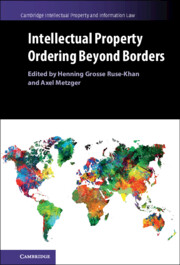This book is the outcome of a two-year research project jointly hosted by the Centre for Intellectual Property and Information Law (CIPIL) and the Lauterpacht Centre for International Law (LCIL) – both at the University of Cambridge – and the Weizenbaum Institute for the Networked Society, Berlin. The concept was to go significantly beyond a mere collection of conference papers, and rather to start with a structured approach that aims at shedding light on under-researched and often ignored interfaces between IP and various generalist topics as well as critical and socio-economic discussions in international law. At the two workshops in June 2019 in Berlin and in May 2020 (virtually) in Cambridge, initial ideas, then more refined draft papers, were presented to a group of around twenty eminent scholars and experts in the field of international law and intellectual property (IP) law.
The book is aimed at filling a gap in ongoing debates that concern different aspects of IP ordering beyond borders, and which in the last two decades have rather focused on responses to new technologies, critiques of continuous expansion of IP protection and enforcement, as well as on practical matters raised by cross-border IP conflicts – in particular, the jurisdiction of courts, applicable law, coordination of international proceedings, and the recognition and enforcement of judgments. The respective projects of the Hague Conference, the World Intellectual Property Organization (WIPO), and the International Law Association (ILA) have been finalised. Against this background, this book aims to push in a different direction, perhaps to some extent a turning point in the international IP discourse, which has changed part of its focus towards the public international side of global IP ordering. Some of that public international law dimension of course has long been analysed and discussed, at least since the ‘marriage’ of IP and international trade in the 1990s, later complemented by the protection of IP rights via international investment law. The book hence acknowledges, but significantly moves beyond, the literature on IP as part of the global trading regime, and, more recently, the IP–investment interface. It does so by taking a further step back from these specific and by now well researched interfaces, instead considering what we identify as some (but by no means all – as discussed in the introductory chapter) common denominators within public international law and theory, as applied to the protection of IP beyond borders.
The editors would like to thank Hannah Thornton and Tamanna Shokeen for their support in the editing process; the Centre for Intellectual Property and Information Law; the Lauterpacht Centre for International Law and King’s College, Cambridge; and the Weizenbaum Institute, Berlin, for their generous support in holding the workshops. We are particularly grateful that the Open Access publication of this book has been made possible.

